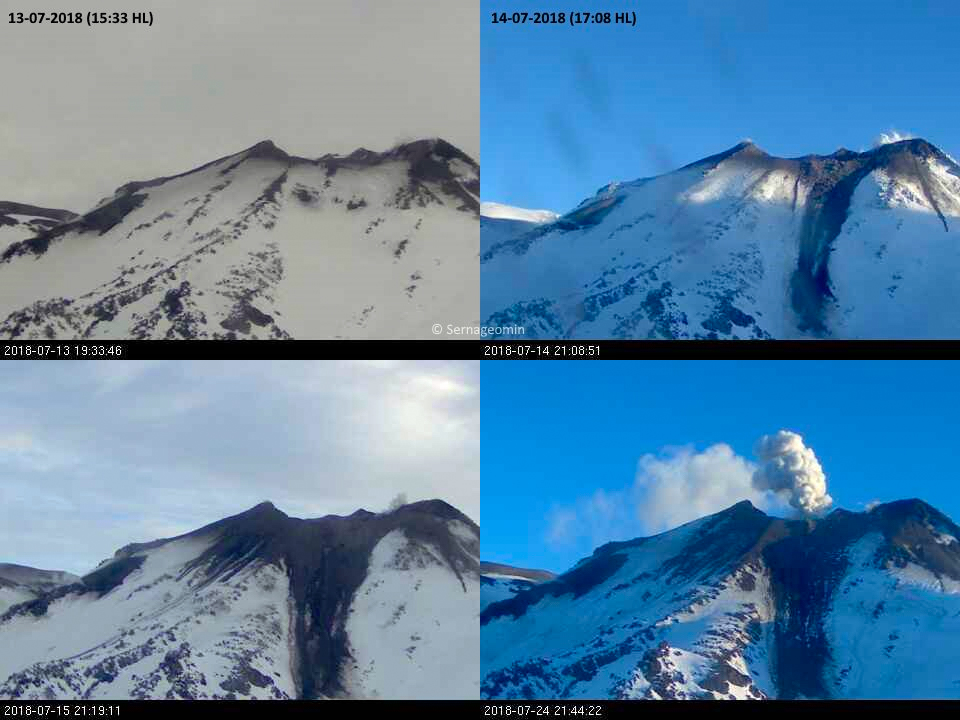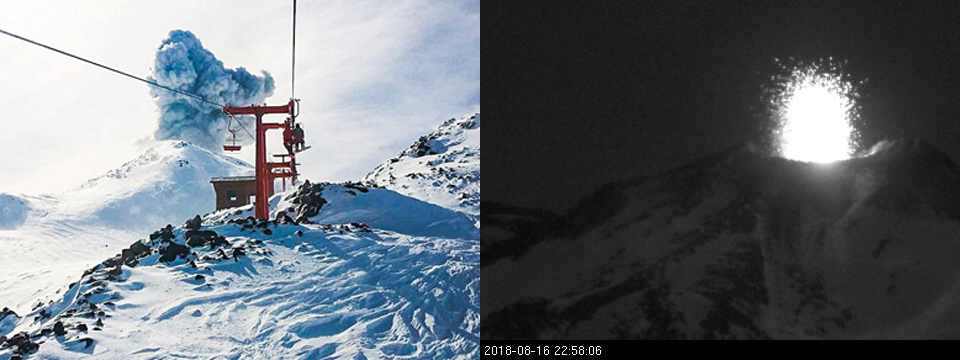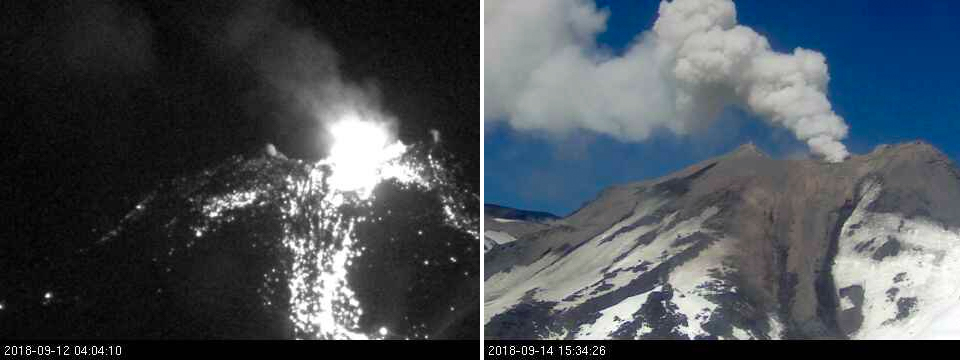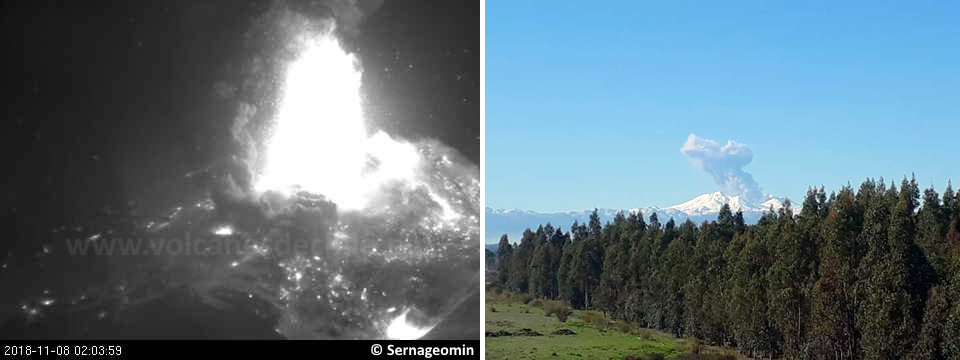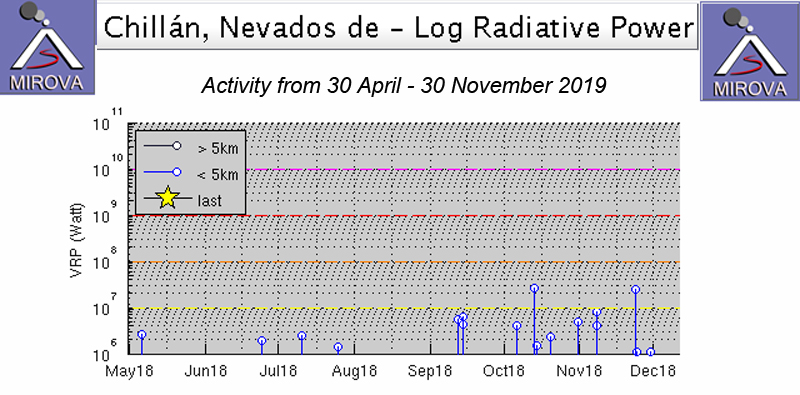Report on Nevados de Chillan (Chile) — December 2018
Bulletin of the Global Volcanism Network, vol. 43, no. 12 (December 2018)
Managing Editor: Edward Venzke.
Edited by A. Elizabeth Crafford.
Nevados de Chillan (Chile) Dome growth and destruction with several explosive events, June-November 2018
Please cite this report as:
Global Volcanism Program, 2018. Report on Nevados de Chillan (Chile) (Crafford, A.E., and Venzke, E., eds.). Bulletin of the Global Volcanism Network, 43:12. Smithsonian Institution. https://doi.org/10.5479/si.GVP.BGVN201812-357070
Nevados de Chillan
Chile
36.868°S, 71.378°W; summit elev. 3180 m
All times are local (unless otherwise noted)
Nevados de Chillán is a complex of late-Pleistocene to Holocene stratovolcanoes in the Chilean Central Andes. An eruption started with a phreatic explosion and ash emission on 8 January 2016 from a new crater (Nicanor) on the E flank of the Nuevo crater, which lies on the NW flank of the cone of the large stratovolcano referred to as Volcán Viejo. Strombolian explosions and ash emissions continued throughout 2016 and 2017. The presence of a lava dome within the Nicanor crater was confirmed in early January 2018; it continued to grow through May 2018. This report covers continuing activity from June-November 2018 when growth and destruction of the dome alternated in a series of explosive events. Information for this report is provided primarily by Chile's Servicio Nacional de Geología y Minería (SERNAGEOMIN)-Observatorio Volcanológico de Los Andes del Sur (OVDAS), and by the Buenos Aires Volcanic Ash Advisory Center (VAAC).
Activity at the Nevados de Chillán volcanic complex from June-November 2018 consisted of continued steam-and-gas emissions and periodic explosions with ash plumes and incandescent ejecta; these caused frequent changes to the size and shape of the Gil-Cruz dome within the Nicanor crater. Incandescent material as far as 300 m down the flank was seen in nighttime and thermal webcam images on multiple occasions. Larger explosive events during 13-15 July, 7-8 August, 11-12 September, 13 October, and 7 November produced significant ash plumes that rose a few kilometers above the summit, covered much of the area around the crater with fresh ash and blocks as large as a meter in diameter, and caused noticeable changes to the size and shape of the dome. A 400-m-long pyroclastic flow traveled down the E flank on 12 September 2018. The highest ash plume, on 7 November, rose almost 4 km above the summit and drifted SE.
Intermittent seismic and effusive activity continued during June 2018. Seismicity consisted of long-period earthquakes (LP) and tremor episodes (TR) related to the growth of the viscous lava dome located in the Nicanor crater, and occasional volcano-tectonic (VT) seismic events. Gray emissions and dark ash covering the snow were reported several times during the month. The dome was visible on clear days from the webcam located in Portezuelo (70 km NW); the thermal camera there showed intermittent evidence of emissions as well, usually as nighttime incandescence and ejecta scattered around the crater. Incandescent material traveled 300 m down the slope on 22 June. The Buenos Aires VAAC reported a brief emission on 23 June that rose to 4.6 km altitude and drifted NE before dissipating. It was accompanied briefly by a hotspot detected in thermal imagery.
Low-altitude steam and gas plumes were visible throughout July 2018 with periodic nighttime incandescence and ejecta blocks occasionally visible around the crater. Three explosions on 13, 14, and 15 July produced seismic events and significant ejecta, and resulted in partial destruction of the dome (figure 26). The event on 13 July was recorded as a M 3.7 located 430 m below the summit. During the night of 13-14 July images showed incandescence and ejecta on the NE flank near the crater ranging from centimeter to meter in size. The thermal webcam measured temperatures around 300?C. The second explosion on 14 July was recorded as a M 3.9 event located 1.4 km below the summit; webcam images in clear weather the following afternoon showed the extent of the new material on the NNE flank (figure 27). The third explosion in the early morning of 15 July was measured as a M 3.8 event and produced an incandescent column 340 m high. Additional ejecta on the NNE slope was visible in the webcam that afternoon. The Buenos Aires VAAC reported a pulse of ash moving ESE on 15 July at 6.4 km altitude. A video taken by SERNAGEOMIN during an overflight on 16 July showed ejecta around the flanks and steam rising from the partly destroyed dome. Intermittent, low-altitude steam-and-gas emissions continued for the rest of the month; light gray emissions were reported from 26 July through the end of the month.
An explosion midday on 7 August 2018 produced abundant high-temperature ejecta around the crater and a 1.5 km high ash plume, according to SERNAGEOMIN. Intermittent gray plumes were reported the next day and for the remainder of August, along with incandescence at night from high-temperature degassing and smaller explosive events (figure 28). The Buenos Aires VAAC reported sporadic and small puffs of ash visible in the webcam on 27 August.
Intermittent gray emissions and minor incandescence at night were typical of the activity during September 2018, except for a series of explosive events during 11-13 September (figures 29). An explosion on 11 September produced ejecta that traveled 300 m down the slope. The largest event, on 12 September, produced a 2.5-km-high dense ash plume and a pyroclastic flow that went 400 m down the E slope. Communities within 1 km of the crater reported ashfall. Drone video footage from 13 September posted by Nicolas Luengo V. showed the path of a block-and-ash flow down the flank and dense steam emissions with ash rising from the partially destroyed dome (figure 30) (Luengo and Palma, 2018). The Buenos Aires VAAC reported a small ash plume at 4.3-4.9 km altitude drifting SSW on 14 September. Satellite images from 16 September again showed partial destruction of the growing dome at the summit from the explosive events.
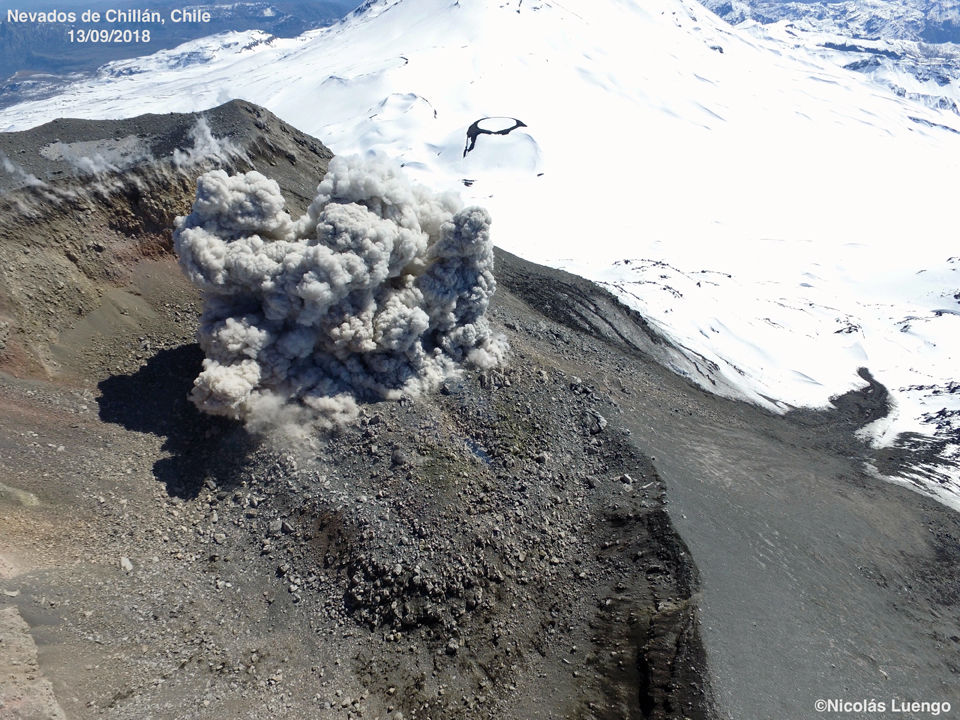 |
Figure 30. Dense steam-and-ash rose from the dome inside the Nicanor crater at Nevados de Chillán on 13 September 2018 in multiple explosive events. Courtesy of Nicolás Luengo, used with permission. |
The Buenos Aires VAAC reported an ash emission to 6.1 km altitude on 13 October 2018 seen in multispectral imagery under mostly clear skies moving SSE, and another isolated emission at the same altitude moving SE on 31 October. SERNAGEOMIN reported abundant ejecta scattered around the crater after the 13 October event. Another explosive event on 7-8 November produced incandescent ejecta and ash plumes that were the highest of the reporting period, rising to 7 km altitude and moving SE as reported by the Buenos Aires VAAC (figure 31).
For most of November 2018, pulsating emissions from the crater were accompanied by nighttime incandescence with small explosions and short-range ejecta. The SERNAGEOMIN webcam captured images of explosions on 23, 27, and 29 November. The Buenos Aires VAAC observed weak pulses of ash in satellite imagery at 3.9 km altitude on 23 and 27 November. The intermittent explosions with incandescent blocks and ash from June through November 2018 produced occasional low to moderate thermal anomalies that were captured by the MIROVA project (figure 32).
Reference: Luengo, Nicolas and Palma, Jose Luis, 2018, Morfometría y tasas de extrusión del domo de lava del Complejo Volcánico Nevados de Chillán mediante el uso de drones eimágenes satelitales, Concepción, Chile, XV Congreso Geológico Chileno, University of Concepción, DOI:10.13140/RG.2.2.35386.64966/1.
Geological Summary. The compound volcano of Nevados de Chillán is one of the most active of the Central Andes. Three late-Pleistocene to Holocene stratovolcanoes were constructed along a NNW-SSE line within three nested Pleistocene calderas, which produced ignimbrite sheets extending more than 100 km into the Central Depression of Chile. The dominantly andesitic Cerro Blanco (Volcán Nevado) stratovolcano is located at the NW end of the massif. Volcán Viejo (Volcán Chillán), which was the main active vent during the 17th-19th centuries, occupies the SE end. The Volcán Nuevo lava-dome complex formed during 1906-1945 on the NW flank of Viejo. The Volcán Arrau dome complex was then constructed on the SE side of Volcán Nuevo between 1973 and 1986, and eventually exceeded its height. Smaller domes or cones are present in the 5-km valley between the two major edifices.
Information Contacts: Servicio Nacional de Geología y Minería (SERNAGEOMIN), Observatorio Volcanológico de Los Andes del Sur (OVDAS), Avda Sta María No. 0104, Santiago, Chile (URL: http://www.sernageomin.cl/), 16 July 2018 overflight video on YouTube (https://www.youtube.com/watch?v=SVFklfEnWXI); MIROVA (Middle InfraRed Observation of Volcanic Activity), a collaborative project between the Universities of Turin and Florence (Italy) supported by the Centre for Volcanic Risk of the Italian Civil Protection Department (URL: http://www.mirovaweb.it/); Nicolas Luengo, University of Concepcion (Twitter: @nluengov), 13 September drone video footage on YouTube (https://www.youtube.com/watch?v=BZt5X3rWoFM); Jaime S. Sincioco (Twitter: @jaimessincioco); Samuel Opazo T (Twitter: @OpazoSamuel).



